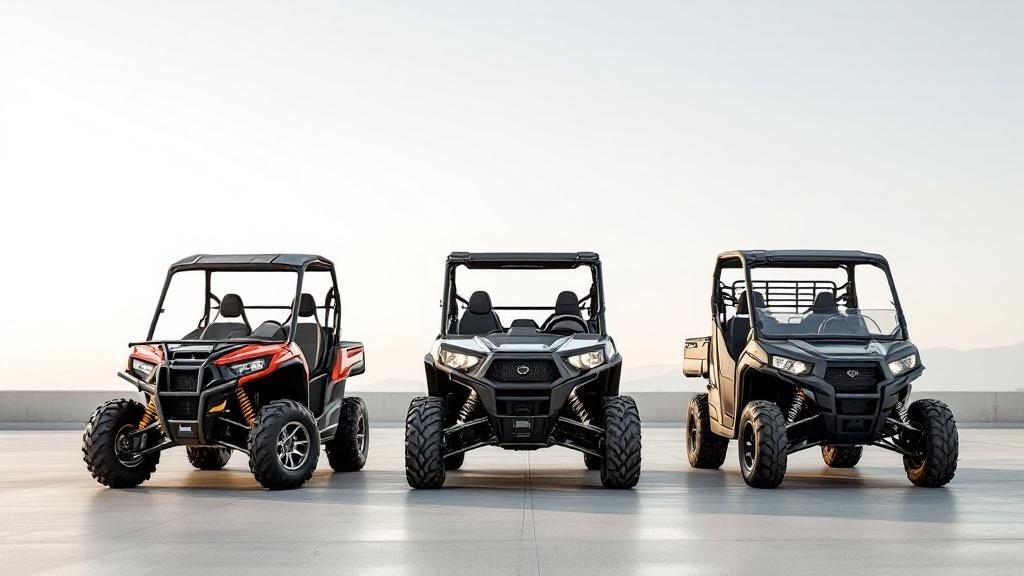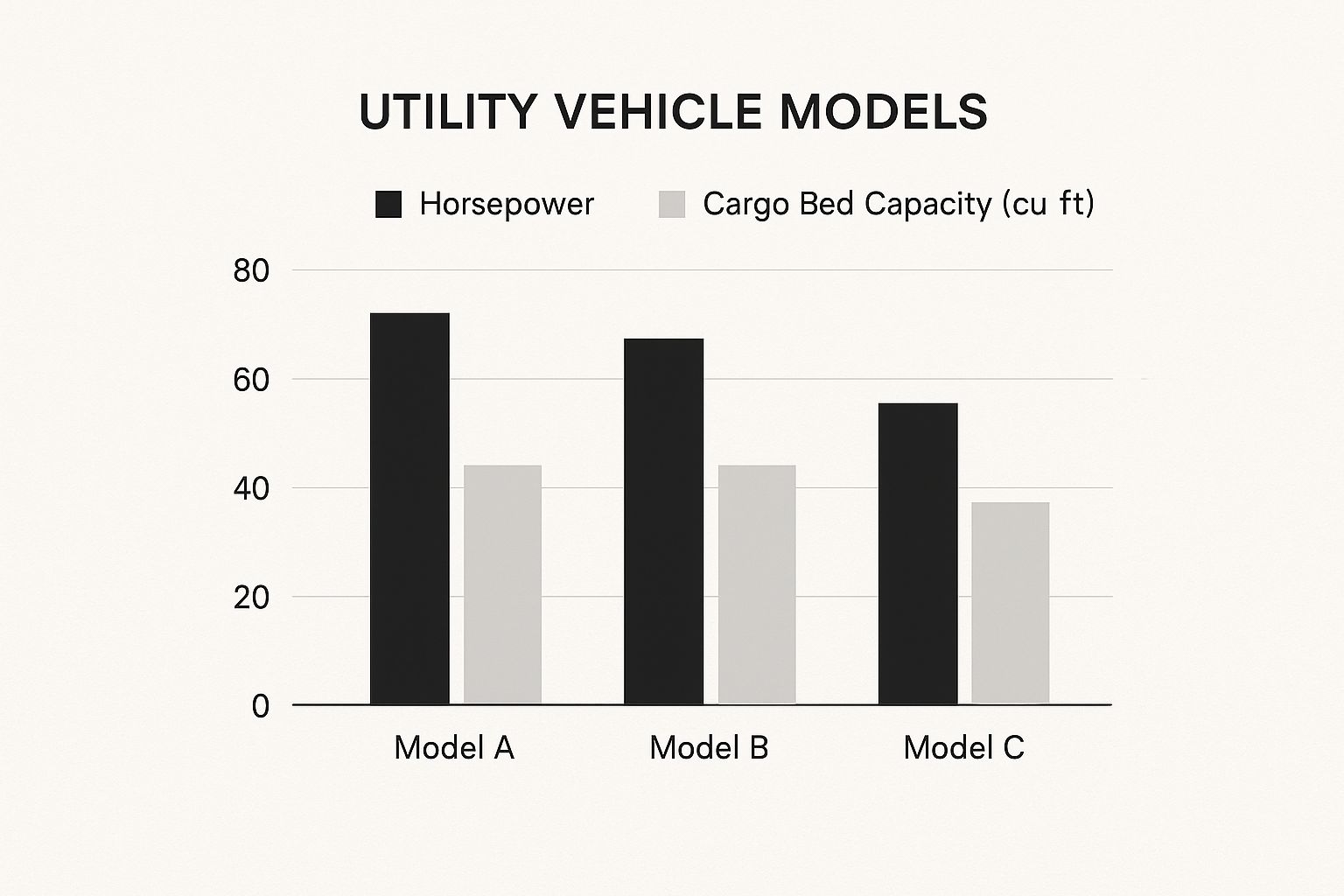When you're trying to pick the right utility vehicle, it all comes down to one big question: are you looking for a pure workhorse or a machine built for fun? A real utility vehicle comparison shows that some UTVs are designed for heavy lifting with massive cargo beds and serious towing power. Others are all about speed and nimble handling for hitting the trails. The right machine for you is the one that lines up with what you'll be doing most often.
Choosing Your Next Workhorse UTV
Picking out the perfect utility task vehicle (UTV) can be a real headache. The market is flooded with options, so you need to look past the spec sheets and get a feel for how these machines actually perform in the real world. This guide cuts through the noise to focus on what really counts for your job, whether that’s hauling hay across the farm or moving equipment on a busy job site.
It's no secret that these vehicles are more popular than ever. The global utility vehicle market was valued at around USD 34.91 billion in 2025 and is expected to balloon to USD 67.59 billion by 2032. That's a steady growth rate of about 9.9% a year, which shows just how essential they've become for businesses and private owners alike. You can dig into more market growth details if you want the full picture.
To make things easier, let's break down the main types of UTVs.
The biggest takeaway here is that there's no single "best" UTV. The right choice is completely situational. It all depends on whether you need raw power, room for passengers, or special tools for a specific task.
Getting familiar with these categories will give you a solid starting point for finding a UTV that's a perfect fit. Here’s a quick look at the main segments to help you figure out where you land.
Key Utility Vehicle Segments at a Glance
This table offers a quick snapshot of the different UTV classes, helping you match your needs to the right type of vehicle.
| Vehicle Class | Primary Use Case | Typical Engine Size | Key Features |
|---|---|---|---|
| Work/Utility | Heavy hauling, towing, job site tasks | 800cc – 1000cc+ | Large cargo bed, high payload/towing, durable frame |
| Recreation/Sport | Trail riding, high-speed performance | 900cc – 1000cc+ | Long-travel suspension, high horsepower, agile handling |
| Crossover/Rec-Utility | Mixed-use, property maintenance | 500cc – 1000cc | Balanced cargo space and performance, versatile features |
By understanding whether your daily tasks fall into the work, sport, or crossover category, you're already one step closer to making a smart decision.
Comparing Powertrains for Real-World Performance
Horsepower and torque figures look great on a brochure, but they don't mean much until you're actually putting the machine to work. A true utility vehicle comparison needs to dig deeper than the spec sheet and get to the heart of these vehicles—the powertrain—to see how it holds up in the real world. You'll find that brands like Polaris, Can-Am, and John Deere offer gasoline, diesel, and electric options, and each one brings something different to the table.

Think about it this way: an engine's torque curve is what really determines if you can pull a heavy trailer up a slick, muddy hill. Horsepower, on the other hand, is more about hitting top speed when you've got a long, flat stretch of ground. Getting a handle on these practical differences is the only way to pick the right machine for the job.
Gasoline Engines: The All-Around Standard
Most UTVs you see are running on gasoline. It's the most common powertrain for a reason—gas engines are known for their peppy, responsive power and high-revving fun. They strike a great balance between work and play, giving you the muscle for chores and the speed for the trails.
The downside? They’re louder and need more hands-on maintenance like oil changes and new spark plugs. Fuel efficiency can also become a pain point on long workdays, often forcing you to haul extra gas cans just to get through the day.
For many, the choice boils down to this: do you need instant, on-demand power, or steady, low-end grunt? A gasoline engine is all about quick bursts of speed, while a diesel engine is the master of the long, hard pull.
Diesel Engines: The Low-End Torque King
When it comes to pure, low-speed torque, nothing beats a diesel. They are the undisputed champs for heavy, nonstop work. If your day involves towing massive trailers or running power-take-off (PTO) attachments, a diesel is built for it. They're designed for longevity and sip fuel under load, often outlasting their gasoline counterparts.
The trade-offs are a heavier machine, more vibration, and a higher sticker price right out of the gate. Their power isn't about being fast; it's about relentless pulling force. This makes them a specialized tool for serious farm or industrial applications.
Electric Powertrains: The Silent Workhorse
Electric UTVs are quickly becoming a serious contender, and they bring some unique perks to the job site. Their biggest advantage is instant torque, meaning you get 100% of the vehicle's pulling power the second you touch the pedal. This makes them incredibly capable for towing and climbing steep grades, often surprising people who are new to them.
On top of that, their nearly silent operation is a game-changer when working around livestock, in quiet neighborhoods, or on a hunting lease. While you have to think about range and charging, the decision is a lot like choosing between an electric or gas golf cart—it all comes down to how you plan to use it. With almost no powertrain maintenance and zero emissions, electric UTVs are a compelling choice for many modern jobs.
How Much Can Your UTV Really Haul and Tow?
When you get right down to it, a UTV’s real value is measured in pounds and cubic feet. In any serious utility vehicle comparison, the conversation always shifts from engine size to pure, brute-force work capacity. It’s one thing to see a 1,000-pound payload rating on a spec sheet, but it's a completely different story when you’re actually loading construction debris, bags of feed, or landscaping materials day in and day out.
Those raw numbers for payload and towing capacity are just the starting point. I've seen plenty of UTVs that look great on paper but struggle in the real world because of other design factors. The strength of the frame, the design of the cargo bed, and how well the brakes perform all have a massive impact on how a vehicle actually handles a heavy load. A UTV might be rated to tow 2,500 pounds, but if the frame starts to flex or the brakes feel mushy on a downhill slope, that number doesn't mean much.
Here's something I've learned over the years: payload capacity isn't just about weight—it's about volume and balance. A deep, thoughtfully designed cargo bed can secure bulky items far better, which makes the entire UTV more stable and safer to operate, even when you're well below the maximum weight limit.
This focus on practical work isn't unique to UTVs; it mirrors what's happening in the broader automotive market. In the United States, utility vehicle sales consistently show a strong preference for vehicles that mix passenger space with genuine functional capacity. Just look at March 2025, when the Ford F-Series pickup was the top seller with 66,905 units sold, and the Honda CR-V led the SUV pack with 45,577 sales. These figures prove that people consistently choose vehicles built to haul and tow. You can explore the latest automotive sales statistics to see these trends for yourself.
Visualizing Workhorse Metrics
Putting horsepower numbers next to cargo bed capacity really highlights the trade-offs you have to make. This chart shows how three popular models balance these two critical specs.

As you can see, more horsepower doesn't automatically mean you get more hauling space. It forces you to get crystal clear about what your top priority really is.
Head-to-Head Workhorse Capability Comparison
To make a smart decision, you have to put the leading models side-by-side. When you start analyzing payload and towing numbers directly, you uncover the subtle but critical differences that can make or break your daily productivity. A difference of just a few hundred pounds in towing capacity could be the difference between getting a job done in one trip or needing two.
This table gives you a direct, apples-to-apples look at these vital stats for some of the top utility vehicles out there. Don't just look at the max weight; pay close attention to the cargo bed dimensions. That's what will ultimately determine what kind of materials you can haul efficiently.
| Model | Max Payload Capacity (lbs) | Cargo Bed Dimensions (L x W x H) | Max Towing Capacity (lbs) |
|---|---|---|---|
| Model A | 1,200 | 43 x 54 x 11.5 in | 2,500 |
| Model B | 1,000 | 36.75 x 54.25 x 12.5 in | 2,000 |
| Model C | 1,500 | 45 x 56 x 13 in | 2,500 |
Looking at this, it's clear that Model C is the heavy-lifter of the group with the highest payload, making it the go-to choice if you're frequently moving dense, heavy materials like gravel or stone.
Calculating the True Cost of UTV Ownership
The sticker price on a utility vehicle is just the beginning of the story. When you’re doing a real utility vehicle comparison, you have to look past that initial number and figure out the true cost of ownership over the long haul. This total cost is everything from daily fuel or charging to long-term maintenance and the inevitable repair.

Think of it this way: a gasoline-powered UTV might seem like a bargain upfront, but its constant need for fuel can drain your budget, especially if you're running it hard every day. On the flip side, an electric UTV often comes with a higher initial price tag but costs pennies on the dollar to "refuel." The savings really start to pop when you consider how much less maintenance they need.
Factoring In Maintenance And Repairs
Maintenance is one of those expenses that sneaks up on you. Gas engines are needy—they demand a steady diet of oil changes, new filters, and fresh spark plugs. While each one seems small, those costs really stack up over a few years of solid work.
Electric UTVs, however, let you skip that entire routine. Their powertrains have far fewer moving parts, which means no oil to change, no filters to swap, and no exhaust systems to fix. You can get a deeper dive into the specifics with guides on https://solanaev.com/electric-vehicle-maintenance/, but the takeaway is clear: the potential for long-term savings is huge. Of course, you’ll still have to deal with brakes, tires, and suspension, but the core upkeep is dramatically simpler.
The big question mark for an electric UTV is its battery. It’s built to last, but just like an engine wears down on a gas model, a battery will degrade over time. That said, a well-cared-for battery pack can easily deliver thousands of charge cycles before you need to worry.
Insurance, Parts, And Warranties
Don't forget about insurance. Rates can swing wildly from one model to another based on things like engine size, top speed, and how much it would cost to replace. It’s always a smart move to get a few insurance quotes for your top contenders before you sign on the dotted line. The cost and availability of common parts, like tires and brake pads, can also vary between brands, impacting your budget down the road.
A solid manufacturer's warranty is your best friend when it comes to avoiding those gut-wrenching, unexpected repair bills. Look for comprehensive coverage on the powertrain and other major systems for at least a few years—it provides priceless peace of mind and could save you a small fortune.
To get a real grip on what your UTV will cost over its lifetime, you need to track everything. Using a system to efficiently manage and track all your business-related jobs and costs will give you a crystal-clear picture of your operational spending. That financial clarity is what allows you to make a smart purchase that pays off for years, not just on the day you buy it.
Matching the Right UTV to Your Work

Let's be honest, the "best" UTV is simply the one that’s right for your work. A spec sheet only tells part of the story. To really figure out what you need, we have to look past the numbers and put these machines into real-world scenarios. This is where you can start to visualize how a machine will actually perform day in and day out.
This kind of practical thinking is key. The demand for capable, versatile vehicles is as strong as ever, with the seasonally adjusted annualized rate (SAAR) for global new vehicle sales in June 2025 projected to be around 15.0 million units. While that figure covers all vehicles, it shows just how much we rely on machines that can get the job done.
Now, let's break down which type of UTV makes sense for different kinds of work.
For the Large-Acreage Farmer
When you're running hundreds of acres, you need a machine built for relentless work. Think durability and pure, brute strength. Your daily grind probably involves hauling heavy feed bags, towing implements across muddy fields, and covering long distances. For this, a diesel model with a high-torque engine and a beefy, steel-reinforced cargo bed is your best bet.
- Game-Changer: A Power Take-Off (PTO) option is a massive plus. It lets you run attachments like spreaders or mowers directly from the UTV's engine, turning one vehicle into a multi-tool.
- Non-Negotiable: Look for a payload capacity that clears 1,200 pounds and a towing capacity of at least 2,500 pounds. Anything less just won't cut it for serious farm equipment.
For the Commercial Landscaper
Landscaping crews are all about efficiency and agility. You’re maneuvering through tight residential spaces, moving bulky materials like mulch and pavers, and often working in neighborhoods where noise is a real issue. An electric UTV shines here. Its silent operation keeps clients happy, and the instant torque is perfect for getting heavy pallets moving without a fuss.
For a landscaper, a hydraulic-assist dump bed isn't a luxury—it's a time-saver. It eliminates a ton of physical labor and dramatically speeds up unloading, which means more productivity and more jobs done each day.
If you’re running a larger operation, choosing the right UTV also means thinking about the specific considerations for fleet vehicles to keep your entire crew running smoothly and efficiently.
For the Construction Site Manager
Job sites are pure chaos. For a construction manager, the top priorities are crew safety and all-weather reliability. A fully enclosed cab with heat and A/C is an absolute must-have for keeping work going year-round, not a perk.
- Critical Feature: Don't even think about it without puncture-resistant, 8-ply tires. The ground is littered with nails, rebar, and other sharp hazards.
- Must-Have: You'll also need excellent ground clearance and a robust, full-body skid plate to protect the vehicle’s guts from getting torn up. For some, knowing https://solanaev.com/street-legal-utv-2/ is also valuable for making quick trips between nearby sites.
For the Mixed-Terrain Property Owner
If your land is a mix of everything—manicured lawns, dense woods, and rocky trails—you need a versatile machine. A crossover UTV strikes that perfect balance between a comfortable ride and real work capability. The most important feature here is an adaptable suspension that can soak up the bumps on the trail but isn’t too soft when you’ve got a load in the bed.
Common Questions When Choosing a UTV
When you've narrowed it down to your final contenders, a few practical questions always seem to pop up. Answering these is often the last step between getting a good UTV and finding the perfect one for your work. Let's clear up some of the most common points of confusion so you can make your final choice with complete confidence.
What Is the Biggest Difference Between a UTV and an ATV?
The core difference really comes down to how they're designed and what they're built to do. A Utility Vehicle (UTV), or side-by-side, is basically a compact, rugged truck. You get a steering wheel, gas and brake pedals, and bench or bucket seats for anywhere from two to six people. Its primary role is work, and you can see that in its large cargo bed and serious payload and towing capacities.
On the other hand, an All-Terrain Vehicle (ATV) is a single-rider machine. You steer with handlebars and sit on it like a motorcycle. ATVs are nimble and fantastic for recreational trail riding or handling small, quick jobs. But when it comes to hauling a crew, moving heavy materials, or tackling a demanding workday, the UTV is in a class of its own.
Here’s the simplest way to think about it: You ride on an ATV, but you drive in a UTV. That small distinction says everything about their different strengths and purposes.
Are Electric Utility Vehicles Powerful Enough for Heavy Work?
Absolutely. Modern electric UTVs are not just capable; they're often better suited for certain kinds of hard work. Their biggest advantage is instant torque. The second your foot touches the pedal, you get 100% of the vehicle's pulling power. This is a massive plus when you're trying to pull a heavy trailer from a standstill or claw your way up a slick, muddy hill without losing momentum.
While some gas models might boast higher top speeds, the silent operation of an electric UTV is a game-changer. It's perfect for working around livestock without spooking them, maintaining grounds at a resort, or handling early-morning jobs without waking up the neighbors. The main things to plan for are battery range and having a place to charge, but for most defined work areas, their raw power and dramatically lower running costs make them a superior tool for the job.
How Much Maintenance Does a Typical Utility Vehicle Require?
You can't skip routine maintenance if you want your UTV to last. A standard gas-powered model needs a service schedule much like a car—think regular oil and filter changes, checking the air filter, and keeping an eye on differential and transmission fluids.
You'll also need to keep a close watch on the key wear-and-tear items:
- Tires: Check for correct pressure and good tread.
- Brakes: Look at pad life and fluid levels.
- Suspension Components: Inspect for any damage or leaks after rough use.
- CV Boots: Check for tears, as a ripped boot can quickly destroy an axle.
This is where electric UTVs really shine. They simplify maintenance in a big way. With no engine oil, spark plugs, or exhaust system to worry about, powertrain upkeep is nearly zero. You'll still need to service the brakes, tires, and suspension, but your main job is just monitoring the battery system's health. No matter which you choose, sticking to the service schedule in the owner’s manual is the best way to keep your machine ready to work.
Should I Choose a Model with a Fully Enclosed Cab?
Whether or not you need a fully enclosed cab comes down to your local climate and how you intend to use the UTV. It's a significant investment, but one that can completely change how and when you can work.
If you operate year-round in a place with brutal winters, constant rain, or extremely dusty fields, a full cab is less of a luxury and more of a necessity. A complete system—roof, windshield, doors, and a heater/AC unit—offers critical protection from the elements. It keeps you safe, comfortable, and productive in weather that would send you indoors otherwise.
However, if you're in a milder climate or mainly use the UTV for fair-weather tasks where you prefer the open air, a full cab might be overkill. You can get by just fine—and save a lot of money—with a more basic setup like a ROPS (Rollover Protection Structure) with a roof and a front windshield to keep the wind and bugs out of your face.
Ready to experience the silent power and low-maintenance benefits of an electric UTV? Explore the premium lineup at Solana EV and find the perfect model to elevate your work or recreation. Discover our vehicles.
